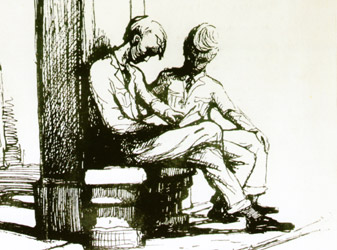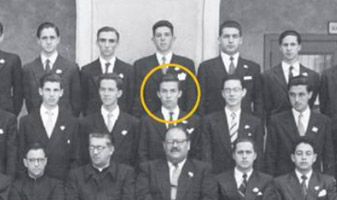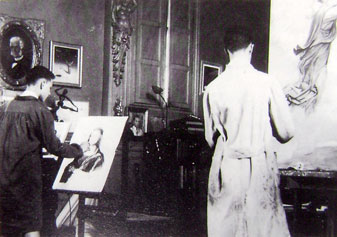THE BEGINNING: VALPARAÍSO AND THE CHILEAN COUNTRYSIDE
|
| |
| "My son, an artist... no way!" |
| Tomás Bravo, Claudio Bravo's father, says about the projects of his son. |
 |
| W |
hen Claudio Bravo was about nine years old, he went with his mother and one of his sisters to an old colonial mansion in Viña del Mar. |
| The house had been turned into a museum, one of the few art museums in Chile in those days. Most of the works on view there were by contemporary local painters, yet there was also a small collection of plaster casts of antique sculptures. While their mother spoke to them about the paintings, their attentions were captured by something else. Coming into a room of life-size copies of Greek statues, they saw a nude Hermes and Venus. They said nothing, staring at the statues in amazement. Their mother, however, hurried them out of the room exclaiming that such things were not for the eyes of children. Neither Claudio nor his sister has ever forgotten this. It was his first introduction to art in museums. His second visit was made several years later. That time, however, he made sure to go alone. Such a seemingly minor incident is, ironically enough, of significance in our understanding the art of Claudio Bravo as it touches on two aspects of continuing importance in his work: classicism and eroticism. |
 |
A FAMILY OF LANDOWNERS
ON THE CHILEAN COUNTRYSIDE |
 |
| Claudio Nelson Bravo Camus was born in Valparaíso, Chile, on November 8th, 1936. He is the eldest son in a family of seven children (he has one elder sister). Concerning the burden of being the eldest son, Bravo states: "I always thought I had a great responsibility being the oldest male child. I wanted to get lid of it and become a painter. I refused to have anything to do with my family's business affairs."
Bravo's father, Tomás, was a wealthy landowner who had three ranches, "My father was a rich man who loved cars, tractors and farm animals" says Bravo (he owned one and rented two) near Santiago. Claudio was destined to follow the path of his family's fortune, caring for the land and the cattle raised on it. As a teenager his father obliged him to work on the ranches and at cattle fairs to gain the proper experience for this work. He was completely disinterested in it. However, and never even considered it seriously. What Bravo seems mostly to have disliked were the many cows on the family ranch. He remembers that, one day, when he was about 14 or father took him for a long ride on horseback to see the land he owned. "It was like the temptation of Christ," he says. "We went on horse up into the mountains. My father showed me the three fincas, one right next to the other, and said 'You're the oldest boy. All this land and all its cattle will be yours soon.' I was horrified. What would I ever do with so many cows? I gained a distaste for cows then and I've never painted them since. Livery time I see a cow painted by Rubens or one of the Dutch masters I say to myself 'what an ugly animal!'." |

|
| EDUCATION IN SAN IGNACIO SCHOOL |
 |
| His formal education took place in Jesuit schools, in Santiago, from 1945 to 1954. Although he later rejected the tenets of his Catholic upbringing, he traces his interest in the mysterious aspects of religious life and ceremony as well as his fascination for the lives of the saints to the training he received from the Jesuits.
Bravo's father was hostile to the idea of his son's career in art. “My father had very little interest in art. He always said to me ‘Finish your studies and then you can dedicate yourself to painting.’ He thought, of course, that by that time I'd forget art altogether. One day he even burned all my painting materials. I'd become obsessed by painting and did nothing else and I hadn't done some task that he asked me to do, so he burned all my paints and brushes.” Bravo says. “I began to draw long before I took any formal classes. The little bed that I slept In until I was about ten years old is still in our house in Chile. It had been painted bright red and then there was a coat of beige paint over that. I would take a nail and trace scenes of cowboys and Indians, all of which were very realistic.” |
 |
 |
 |
| Cover of the San Ignacio Students Magazine, drawn by Claudio Bravo. |
 |
| PUPIL OF MIGUEL VENEGAS |
 |
| “In school I was obsessed by drawing. The prefect of my elementary school (Father Dusuel), a difficult and very aggressive person, discovered my notebooks filled with drawings and he liked them. I liked him and was always at his side. He became my confessor (he was a Jesuit). One day he said to me: ‘Even though your father doesn't want you to paint, I'm going to take you to the studio of Miguel Venegas so that you can see it.’ Venegas was the only art teacher in Santiago and when I began to go to his school, it was like I had discovered the world for the first time. Everything seemed fabulous and beautiful to me”, Bravo remembers about his first art classes, in 1945. |
|
|
 |
 |
 |
| Claudio Bravo next to his classmates. (Image: courtesy San Ignacio School Archive) |
 |
| Venegas, a 'conservative romantic' as Bravo describes him, was a good teacher who had also taught Sebastián Matta and other less well-known Santiago painters. The basis of Venegas's teaching technique was copying. There were numerous reproductions in the studio of old master paintings and drawings as well as plaster casts. "I was always having to make perfect copies of the masters. It’s something that's stayed with me. |
 |
 |
[MY FATHER] TOLD ME:
"YOU´LL STARVE,
YOU'LL BE A FLOP, A BUM" |
 |
In his studio, I copied works of old masters like Vermeer, Fra Angelico and Baldovinetti. Venegas also taught Matta.” During the first month Bravo’s father knew nothing of these classes. “Later my father learned of this and reluctantly let me continue. But he often said ‘You'll starve, You'll be a flop, a bum’.” Chile.
Bravo remembers that often, in the afternoons, many of his teacher's friends would come into the studio on the calle Alonso Ovalle, drink pisco sours and get "just a little drunk." They would ask the young student to do pictures for them, copies of Leonardo drawings, sections of the Sistine ceiling or works by artists like Baldovinetti. There was no life drawing class, however. "Venegas was very controlled by religion and wouldn't allow nudity in his classes. He himself often painted nudes, however. I posed for several of them. It never bothered me to pose nude; it was very natural. I remember seeing a photo of Ronald Reagan one day posing nude in an art class when he was young. That made me admire him”.
If Bravo's father was against his son's artistic studies (although he once asked Claudio to paint a sunset with four large cows in the foreground), his mother, Laura Camus Gómez, supported his interests. She had been an amateur artist in her youth. "She painted beautiful, sensitive flowers." says Bravo. "She lived to see me make a success of myself and was very happy. My father died when I was 15."
Bravo remained in Venegas's studio for three years. It was the only formal instruction he received. "I was actually forced to leave. One day a friend (who is now a portrait painter in Rome) and I had a mock duel in the studio. We took swords that were hanging on the wall and began to fight. We damaged one of Venegas's paintings and he threw us out. I was offended and wouldn't return. Then, after two years, my father died. Venegas sent me a letter of condolence which was, in effect, a letter requesting me to return to him. I did, although I didn't take any more classes from him or anyone else. I learned a great deal from him, though.” The artist and his teacher had a reconciliation that developed into a friendship after Bravo had realized his early- success in Chile. |
 |
 |
| Paintings lessons with the teacher Miguel Venegas (right) |
 |
| THE LATIN AMERICAN HERITAGE |
 |
Bravo had fairly little opportunity to study works of art other than those in the studio of his teacher. He became familiar, however, with a wide variety of European artists' work through books and periodicals. Years later, when he went to Europe, there were, he says, few real surprises in the museums and galleries, as he had seen so much already ("I had, however, little idea of the scale of the paintings and sculptures I had seen in the reproductions."). Bravo claims to have received little or no inspiration from the art of other Latin American painters of either his or previous generations. Unlike the case of many Hispanic artists of today, there are no hints in either Bravo's color or his subject matter of a Latin American identity. There are also no traces of indigenous elements in his painting. "I am only South American because of my passport.
My art has nothing to do with my heritage. I am very connected to the European past—to ancient art, to Renaissance art. Even when I do a painting of a contemporary scene, as in my New York pictures, its roots are in Italian art of the 15th century." Bravo's work has itself influenced a number of younger painters, many of them from Latin America. He has never had a strict pupil-master relationship with anyone, however. "Sometimes I will invite a young artist to my house in Tangier and watch them paint and criticize their work." The closest he ever came to formal teaching was when he served as assistant to a professor of architectural drawing at the Catholic University in Santiago in the mid-1950's. |
|